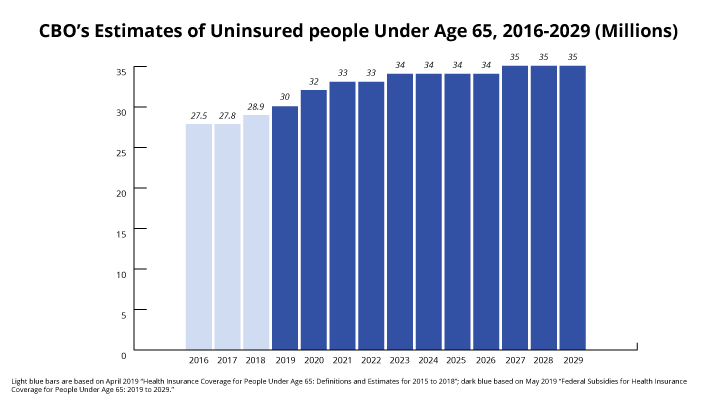On May 2, the Congressional Budget Office issued its new baseline, including health coverage projections for the period 2019-2029. CBO expects the number of non-elderly uninsured people nationwide will increase by 5 million over the next ten years, from 30 million in calendar year 2019 to 35 million in calendar year 2029.
That is in addition to the roughly 2.5 million increase in the number of uninsured that has already occurred from 2016 (27.5 million) to 2019 (30 million), based on earlier CBO estimates from April 18 combined with these new projections. Altogether, CBO thus expects that there will be more than 7 million more uninsured in 2029 than there were in 2016.
According to CBO, the repeal of the Affordable Care Act’s individual mandate penalty is the primary contributor to these troubling coverage trends, resulting in 7 million more people who are uninsured by 2021, relative to prior law. In 2021, CBO expects there would be 4 million fewer people enrolled in the individual market either because they chose not to enroll without the mandate penalty or because they faced higher premiums resulting from fewer healthier people enrolling in the overall non-group risk group. There would be 2 million fewer enrolled in Medicaid and CHIP because of the lack of the penalty or because fewer people apply for marketplace coverage and learn they were eligible for Medicaid. Finally, there would be 1 million fewer enrolled in employer-sponsored insurance because some employees would no longer enroll without the penalty.
Another factor driving the increase in the number of uninsured is greater enrollment over time in plans — like short-term plans —promoted by the Trump Administration that do not comply with the ACA’s market reforms and consumer protections and do not meet the definition of health insurance because they lack comprehensive major medical coverage. These coverage losses, however, are offset, in part, by the effects of some additional states taking up the Medicaid expansion and more people enrolling in non-ACA-compliant individual market plans that still provide major medical coverage, as CBO assumes.
Image Caption: Light blue bars are based on April 2019 “Health Insurance Coverage for People Under Age 65: Definitions and Estimates for 2015 to 2018”; dark blue based on May 2019 “Federal Subsidies for Health Insurance Coverage for People Under Age 65: 2019 to 2029.”


